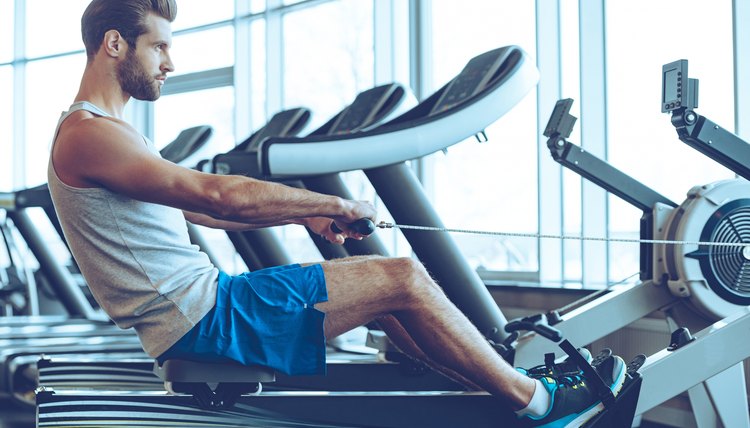What does fact checked mean?
At SportsRec, we strive to deliver objective content that is accurate and up-to-date. Our team periodically reviews articles in order to ensure content quality. The sources cited below consist of evidence from peer-reviewed journals, prominent medical organizations, academic associations, and government data.
The information contained on this site is for informational purposes only, and should not be used as a substitute for the advice of a professional health care provider. Please check with the appropriate physician regarding health questions and concerns. Although we strive to deliver accurate and up-to-date information, no guarantee to that effect is made.
Back Row Exercises (with Video)

Are you tired of only doing deadlifts? Target all the muscles in your back with rows, a versatile back exercise with plenty of variations. Some types allow you to use more weight and target a lot of muscle groups at the same time, while others require you to drop the weight down and focus on a few muscles. Most rows will focus on your lats, or latissimus dorsi, in your upper back but, depending on the range of motion, they can also work your rhomboids and rear delts as well. Either way, back strength can be gained and you can build muscle using these strength training workout.
1. Cable Row
This back workout and row variation is effective as long as you minimize the amount of momentum you gain by leaning back during the pulling movement.
HOW TO DO IT: Get into starting position by sitting at the cable machine and bracing your feet on the floor or platform that some machines feature. Grab the handle with both hands. Lean back slightly. Hold your upper body in this position.
Pull the handle back toward your chest. Touch the sides of your chest with your hands, pinching your shoulder blades together and sticking out your chest to maximize the amount of back muscle used. Slowly lower the weight until your arms are straight to keep proper form.
2. Dumbbell Row
In this row variation, you'll be performing the exercise with a single arm at a time which maximizes the amount of abdominal activation you get in the exercise, according to a 2015 study in the International Journal of Sports Medicine that compared cable and free-weight rowing exercises.
HOW TO DO IT: Facing the side of a workout bench, stand with a dumbbell at your feet. Lean over by sticking your butt back and bending your knees. Plant on hand on the bench and grab the dumbbell with the other hand. Pull the dumbbell up until it touches your chest. Lower the dumbbell back down to the floor.
3. Bench Row
This is one of the best exercises in the row family for bodybuilding because it prevents you from using momentum from your upper body to help get the weight up. According to the American Council on Exercise, the bench row is also a great exercise for muscle growth in the rear deltoid, which is the muscle in the back of your shoulder.
HOW TO DO IT: Lie on your stomach on an incline bench, which should be set at a 45 degree angle to the ground. Keep your head above the top of the bench and feet on the ground.
Holding one dumbbell in each hand, pull the weights up to chest-height, pinching your shoulder blades back at the top of the movement. Lower the weights back down until your arms are straight, relaxing your back and letting it stretch. You can also do this with a barbell using a neutral grip, or overhand grip, similar to a bench press.
4. Lawnmower Row
This is a version of the dumbbell row that doesn't require a bench and allows you to use more weight.
HOW TO DO IT: Place a dumbbell on the floor. Stand on the right side of the dumbbell and get into a lunge position with your right leg forwards. Lean your right arm on your right leg and grab the dumbbell with your left hand.
Pull the dumbbell up until it hits the left side of your chest, turning your torso to the left to gain momentum. Lower the weight down to the floor. Repeat on both the left and right sides.
5. Barbell Row
This is the best row exercise overall for maximum muscle recruitment, according to a study published in the Journal of Strength and Conditioning Research in 2009, which compared three different row exercises. It also puts the highest amount of pressure on your lower spine, so it's not recommended for people with lower back problems or those adverse to back pain. You can also use a T bar to do this as well. This exercise is also known as a bent-over row.
HOW TO DO IT: Grab a barbell with your hands shoulder-width apart. Stick your butt back and lean forwards with your upper body until the barbell is touching your knees.
Pull the barbell up towards the bottom of your sternum, pulling your shoulder blades back and sticking your chest out as you pull up. Try to keep your upper body still except for your arms and shoulders. Also make sure to keep your glutes and core engaged. Lower the weight back down to knee-height.
6. Inverted row
Inverted row is a bodyweight exercise that works all of your “pull” muscles. These include your forearms, biceps, and your core as well.
HOW TO DO IT: Set a barbell at about waist height and get underneath it lying face up. Grab the bar and pull yourself up while keeping a plank-like form. Do this until your chest reaches the bar and lower yourself back down.
Explore In Depth
References
Writer Bio
Henry is a Philadelphia-based personal trainer and writer. He has trained a wide range of clients, from professional athletes to working professionals. Feel free to contact Henry with any questions regarding an article that he's written.
